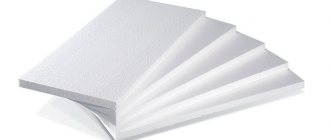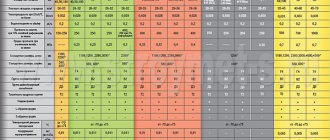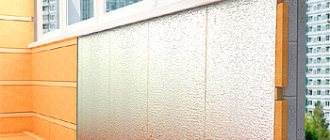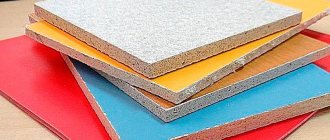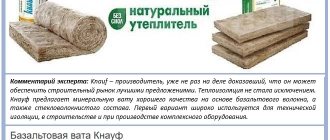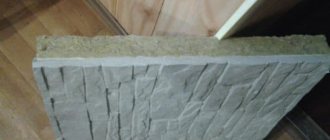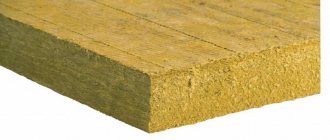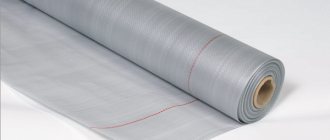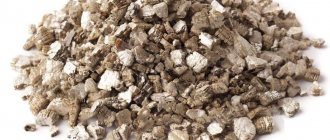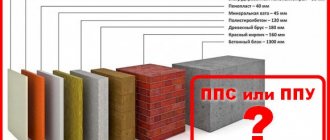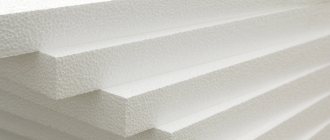Foamed polyethylene insulation also has another name - polyethylene foam (PPE). It is used to reduce the intensity of heat loss; in fact, this material is in many ways superior to some analogues, which is due to its closed-porous structure . PPE is characterized by a large number of positive qualities - minimal thickness, low thermal conductivity, etc. Insulation of this type is installed without unnecessary difficulties. In addition, the film is elastic, which allows better protection of complex surfaces.
Main characteristics and features of the material
The insulation is made from foamed polyethylene, which ensures its ability to protect surfaces from moisture. It represents a class of gas-filled thermoplastic polymers. The content of gaseous substances inside the pores helps to improve the thermal insulation properties. Another name for materials in this group is polymer foams and thermoplastics. To obtain PPE with the desired properties, high/low pressure polyethylene is used as a raw material. Different production technologies are used:
- direct extrusion;
- foaming of polyethylene material through a gaseous medium.
First, the raw material is melted at a temperature of +115 °C. When the desired consistency is achieved, add gas/nitrogen. Such substances contribute to the structuring of polyethylene.
The foaming process is implemented using the following methods:
- physical;
- chemical.
To avoid the formation of larger inclusions, the mass, consisting of gas-filled capsules, rotates continuously. After some time, the liquid material is poured into molds and cooled. Taking into account differences in production methods, different types of insulation are created:
- gas foam (not cross-linked);
- cross-linked foamed by physical/chemical means.
During the manufacture of the latter option, changes occur at the molecular level: a three-dimensional mesh is formed, which is possible after linking molecules and forming cross connections. If we consider insulation obtained by physical and chemical cross-linking, in this case there is no significant difference in the structure, but there is a difference in the production methods. The coating is made on the basis of foamed polyethylene in two versions: rolls, mats.
Foamed polyethylene for insulation, how to use, features
A relatively new insulating material is foamed polyethylene. Ordinary polyethylene can be found everywhere - bags, handles, pipelines, containers, forms...
The high consumer qualities of this material, first of all, resistance to impacts and environmental friendliness, are inherited from foamed polyethylene. It is available in different densities, can be in the form of a film or in a certain form. Read more about the characteristics of foamed polyethylene and its application below.
Types, characteristics of foamed polyethylene
Foamed polyethylene is divided into cross-linked and non-cross-linked.
Non-crosslinked is obtained by mixing polyethylene with a gas mixture - propane-butane. This material differs from cross-linked material in its lower density - 20 - 25 kg/m3. We find it as a substrate for laminate or packaging.
Cross-linked polyethylene foam can be formed in two ways:
- chemical, with complex chemical transformations of the source material;
- physical (radiation) using energy beams to create foam.
The result is polyethylene foam with a higher density of 25-200 kg/m3, but also with greater water absorption - 1% versus 0.2% for non-crosslinked foam. Denser foamed polyethylene is used in various industries, incl. and in the automotive industry, we can find it as tubular insulation for pipelines.
Other characteristics of foamed polyethylene:
- Thermal conductivity coefficient - 0.038 - 0.045 W/mS depending on the density. Heat-saving properties at the level of modern insulation materials.
- Vapor permeability coefficient – 0.01 mg (m*h*Pa). We have a vapor barrier in front of us.
- Permissible operating temperatures – – 40 – +70 degrees. C. Cannot be near hot piping.
Where is it used?
Good sound-absorbing properties, especially with regard to low-frequency impact sound, combined with a low price, almost gave the material a second name - laminate substrate.
In this capacity, it is used with a thickness of 3 - 10 mm and a density of up to 30 kg/m3. It acts primarily as a sound absorber and compensator for minor irregularities, and increased thermal insulation in some cases is only an additional bonus, but not the main reason for choosing this material.
Packaging anything and everything. When transporting, it is important that many useful things, from a plate to an expensive appliance, are not damaged or subjected to critical loads from vibration or accidental impact.
And everywhere, the vibration absorber and packer, along with foam plastic, is foamed polyethylene. Opening the box with a newly purchased food processor, we throw away the packaging without looking, and it was...
For example, in cars you can also find foamed polyethylene both as a sound absorber and as a material that stabilizes the temperature inside the cabin. Pipelines are insulated with a dense shell. We will consider the issues of insulation with foamed polyethylene in more detail.
How is thermal insulation performed?
For insulation, foamed polyethylene is used as a vapor barrier layer with an additional insulating effect. It is not uncommon when, according to calculations, a thickness of insulation is required that is slightly greater than what is usually produced by the industry.
Instead of applying an additional layer, the designer introduces a layer of foamed polyethylene instead of a vapor barrier membrane, and underneath it also an air layer 1-2 cm thick, which is also a heat-insulating layer.
As a result, the thickness of the main insulation is reduced, for example from 19 to 15 cm, according to the thermal calculation, due to additional polyethylene foam with a reflective foil layer and an air gap above it.
Reflection of beam energy
Foamed polyethylene covered with a metallized film (foil) is used mainly with a system of electric heated floors, as a vapor-proof layer, additional insulation to the main insulation layer, and as a reflector of radiation energy.
For electric heated floors, most of the energy produced is in the form of infrared radiation.
Certain types of electric emitters (infrared heated floors) generate an overwhelming amount of energy in the form of infrared radiation, without heating to a high temperature, but heating all dense objects in the room with radiation.
It is clear that without effective reflection from below, a significant part of the energy will be wasted.
Foiled polyethylene foam should be used only for its intended purpose, like any foil. Covering a room with it on all sides disrupts the normal distribution of electromagnetic fields, which is harmful to any living organism.
Questions of increased or disturbed electromagnetic fields also arise regarding electric heated floors...
Don't believe advertising
Many companies produce vapor barrier and insulation (sound-absorbing) films made of polyethylene foam under different brands. Penofol, aluf, polyfoam, etc. are now widely known.
Their advertising often misleads consumers, proving that “miracle insulation will conquer all.” At the same time, simple truths are forgotten that foamed polyethylene with a thickness of 0.7 cm cannot in any way replace the main insulation layer, for example, made of polystyrene foam, which is required to achieve optimal thermal resistance from an economic point of view, no less than 10 cm.
It is possible to supplement thermal insulation with a thin layer of this material in some structures, but it will not be possible to replace it.....
Scope of application
Foam insulation is used in various industries, which is made possible due to its excellent thermal and sound insulation, as well as a number of other properties. Main areas of application:
- construction of facilities for various purposes;
- packaging material;
- furniture manufacturing;
- production of sports equipment;
- production line for prosthetic and orthopedic products;
- light industry;
- electrical engineering;
- Automotive industry;
- shipbuilding.
The use of foamed polyethylene is justified in any cases where it is necessary to provide protection from noise, reduce the intensity of heat loss, and also provide waterproofing.
The possibility of using insulation on different objects is due to its versatility. You should know that it is allowed to use cross-linked PPE, which was made by chemical or physical compounding, for the same purposes. This type of coating is used to insulate various objects, surfaces and objects, including:
- double glazed windows;
- doors;
- underlay for laminate;
- foundation;
- floor;
- walls;
- roof;
- ventilation systems;
- car interior, etc.
Application
Although installation work with this material is characterized by increased simplicity, ease and does not require any special skills at all, there are still a number of requirements for this process:
- before you begin installation, simply gluing the insulating polyethylene material to the surface, it should be thoroughly cleaned, all damage, if any, should be repaired and thoroughly primed, in at least two layers;
- the material is laid on a wall well coated with glue, or by leaning the “built-in” adhesive layer against the surface, while additionally securing it with staples or “fungi” dowels;
- On top of the insulation layer, if necessary or desired, you can mount a frame on which to later attach either a base for a “living” wall or ready-made finishing panels. Or anything else;
- the foil layer is always laid this way - for external gluing - outward, that is, “outside”, to reflect the cold, and for internal installation - inward, to prevent the outflow of heat;
- The joints of the material must be well glued, avoiding the appearance of gaps or cracks; for maximum reliability, they should be additionally glued with metallized construction tape for insulation.
When wrapping pipes yourself in a “fur coat” of polyethylene insulating layer, there is also nothing complicated. On finished heat-insulating cylinders there is a line of punched holes, which is often mistaken for perforation.
We recommend: Peat briquettes, use of peat for heating rooms, its types, advantages and disadvantages
However, the perforations on the material are applied in the form of “punctures”, and the dividing line is in the form of a dotted line. Along this dotted line, the “body” of the cylinder is cut, after which it is put on the pipe, and the joint is glued.
A prerequisite is that the pipe is clean and dry when installing the insulator; it is not forbidden to coat the insulated pipe with glue. For metal pipes, you will need to pre-treat them with anti-corrosion compounds and anti-rust agents.
Foamed polyethylene installation technology
Any insulating material requires certain installation specifications.
Foamed polyethylene also has its own characteristics. After cleaning the surface, PPE is glued and secured. The maximum effect is achieved if there is air space between the material and the cladding. To create a layer, a paving sheathing is installed between the isomer and the finishing coating. The frame protects surfaces from moisture accumulation. Condensation formed during sudden temperature fluctuations evaporates. At the same time, the external finish remains intact. To insulate any surfaces, no scrupulous preparation is required. You just need to smooth out the bumps and depressions, clean them from dust, dirt and dry them.
Reflective insulation
To enhance the vapor and heat insulation properties of PPE and NPE, the material is used with foil as a reflective element using heat sealing, and in some cases, polyethylene film is applied, further protecting the polymers from damage.
As a result:
- surfaces are reliably protected from moisture penetration (100%);
- Polymers reinforced with foil greatly improve their thermal insulation properties - they are equivalent to thick brickwork. 15 cm.
Modifications to foil protected material
- External covering. Layered on the thermal insulation material on one side.
- Double-sided coating. It is used for insulation of floors and internal walls.
- Combined coating. One side is treated with glue. The consumer can save money on additional purchase of glue.
- Double coating. A protective film is applied over the foil to protect the material from damage.
- Protection of foil with perforated material. Along with thermal insulation, in some cases it is necessary to make the surface breathable and permeable to steam.
Thermal insulation performs a variety of functions, and it can be useful anywhere. Aluminum foil reflects up to 98% of heat and prevents heat loss. The material is suitable for insulation:
- attic;
- attic spaces;
- niches behind central heating radiators in apartment buildings and cottages.
In addition to the objects mentioned, aluminum-coated material provides excellent protection for industrial equipment. It is characterized by:
- high elasticity;
- excellent sound and heat insulation;
- durability;
- convenient mounting.
The material is safe, easy to cut and install.
Installation of walls using foil polyethylene foam
The polymer is easy to cut. It is placed on a flat surface, using nails, tape, and a stapler for fastening, and layered with a reflective part in the direction of the heat source.
Package
Polyethylene foam for packaging is usually made from non-crosslinked polyethylene polyethylene and is supplied in the form of rolls, finished products or bags of various sizes.
Packaging products made from PPE absorb shock, reduce vibration, and protect against mechanical damage during transportation. To increase strength and enhance heat-shielding properties, packaging materials are covered with foil, kraft paper, nylon or polyethylene film.
PPE packaging is widely used for transporting household appliances, electrical appliances, dishes, furniture, and shoes.
Figure 14. Non-crosslinked PPE packaging.
Pipe shells
Shells for pipes of various diameters. For convenience, the insulation of installed pipes is produced with cuts along the shells, or without cuts. Uncut shells are provided with perforations along the intended cuts.
Figure 10. Polyethylene foam shells.
They are produced with an outer diameter from 6 to 114 millimeters, shell thickness from 6 to 25 millimeters.
Shells insulate heating, cold and hot water supply, ventilation and air conditioning pipelines.
Compensation mats
They are made by gluing sheets of polyethylene foam under the influence of high temperatures. Supplied in the form of sheets measuring 1000x2000 millimeters, with a thickness of ten to one hundred millimeters.
Figure 11. PPE mats.
Harnesses
They are cylindrical seals with diameters from 6 to 120 millimeters. Thin strands with a diameter of up to 12 millimeters are intended for installing expansion joints in concrete floors; strands from 12 to 20 millimeters are used to seal gaps between door and window frames. Thicker strands are used to fill the joints between panels of precast concrete houses.
Figure 12. Polyethylene foam bundles.
Substrate
It is made from cross-linked polyethylene foam and is used as an intermediate gasket between concrete screeds and laminate flooring.
Supplied in rolls up to three meters wide, with a web thickness of two to five millimeters.
Figure 13. PPE floor underlay.
Comparison of manufacturers and prices
Insulation based on polyethylene foam is available in different price categories. Review of manufacturers and average prices:
- Penofol: 1400 rubles/roll – foil covering ( 3 mm, length 30 thousand mm), 2000 rubles/roll – insulation 10 mm thick, 15 thousand mm long.
- Tepofol: with a thickness of 2 mm, the cost is 400 rubles; thickness 5 mm – 1000 rub.
- Energoflex pipe insulation: 15 RUR/roll ( 22x9 mm); 145 RUR/roll ( 110/13 mm).
- Isoflex: 700 RUR/roll ( 25 m length, 2 mm thickness).
If you plan to insulate with polyethylene foam, you should know that the cost is influenced by a number of factors: thickness, length and width of the roll covering. In addition, PPE with a foil layer will cost more than insulation without heat-reflecting material.
Penofol
This is a multi-layer coating based on polyethylene foam. It is covered with a foil layer on one or both sides. This type of insulation may differ in density, structure and thickness. Foiled polyethylene foam has the advantage of additionally reflecting heat emanating from the room, thereby reducing heat loss. Characteristics of foam material:
- temperature regime: – 60 …+ 100 °C;
- high heat reflection coefficient (97%);
- low thermal conductivity – 0.035 W/(m*K).
Basic properties
The technical characteristics of foamed PE are a synthesis of the properties of polyethylenes, soft elastic materials with a low melting point, and foamed substances with their light weight and low thermal conductivity:
- Like regular polyethylene, foamed PE is a flammable material, the maximum operating temperature of which should not exceed +102°C. At higher rates it will melt.
- At low temperatures, even when dropped to -60°C, foamed polyethylene will retain all its properties, including strength and elasticity.
- The thermal conductivity of this product is very low, it is 0.038-0.039 W/m*K, which gives products made from it a particularly high thermal insulation coefficient.
- In direct contact with water, foamed PE absorbs it by no more than 1-3.5% of its volume per month.
- Foamed polyethylene is very resistant to chemically active environments, in particular to oil and gasoline products.
- Does not degrade in a biologically active environment (does not rot, is not susceptible to the action of bacteria and fungus).
- It absorbs sounds perfectly, so PPE can be used for sound insulation.
- Absolutely non-toxic, even during combustion.
- Easy to transport and install,
- Wear-resistant and durable up to 80 - 100 years of service.
INTERESTING! In terms of thermal conductivity and, accordingly, thermal insulation capabilities, foamed polyethylene can be an excellent alternative to many popular thermal insulators: 1 cm thick PPE can replace 5 cm of mineral wool or 15 cm of brickwork.
Flaws
A negative property of foamed PE is its intolerance to ultraviolet rays. Direct exposure to sunlight has a destructive effect on it, therefore both storage and use of foamed polyethylene should take place in places protected from light. Otherwise, the material itself must contain protection, at least in the form of an opaque film.
Foam film
Produced by foaming polystyrene. The coating is characterized by a low thermal conductivity, which makes it possible to use it for insulation of various objects. This type of foam material contains fire retardants. These are special additives that reduce the degree of exposure of the coating to high temperatures. Despite this, the foam film still burns. The insulation has a significant drawback - toxic compounds are released during the combustion process.
The coating retains heat and moisture well. However, it does not allow air to pass through.
The recommended insulation thickness for Russian regions varies between
20-25 cm. Additionally, a waterproofing diffuse material should be used, as well as a vapor barrier. Thanks to this, the foamed foam will be well protected from the effects of moisture contained in the indoor air.
Advantages and disadvantages
Insulation, characterized by a closed-cell structure, has many positive qualities:
- Versatility. The material is suitable for insulating various types of surfaces and objects.
- Excellent moisture and heat protection indicators.
- Foam coating is used as sound insulation if a material with a thickness of 5 mm or more is used.
- Light weight.
- Environmentally friendly.
- Vapor tightness.
- During combustion, the insulation does not emit toxic substances.
- Fungus and mold do not appear on the surface of PPE.
- The foam material is resistant to chemical compounds, which is important in construction.
- Elasticity.
- Elasticity.
- Reasonable price.
- Long service period.
The coating has much fewer disadvantages. These include low strength characteristics. The foam material is not resistant to compressive loads. For this reason, PPE is more often used to insulate horizontal surfaces. Under the influence of ultraviolet radiation, the insulation loses its properties, so it is either covered with a protective coating, or an option is used with a foil layer on top of the base material.
Not everything is so simple with polyethylene foam
The safety of the foam material and its compliance with sanitary and hygienic standards largely depends on the correct choice of gas-forming agent. Several types of gas can be used for production:
- The air-ozone mixture is the cheapest, safest and easiest to prepare for use, but at the same time the most ineffective. The degree of air expansion is small, and the pore sizes differ from each other. Used for foaming non-crosslinked polyethylenes;
- A mixture of propane and butane gases produces polyethylene foam of medium quality; it can be used for the production of both types of PPE. Among the disadvantages is the high flammability of the material;
- Freons provide the highest quality pores. Refrigerants have been used in the production of polyethylene foams since their invention.
Today, due to the widespread ban on the use of freons, foamed polyethylenes based on them are produced only in China and some countries of Southeast Asia and Brazil. The quality of even non-crosslinked polyethylene made using freon is several times higher than that of propane-butane polyethylene foams, not to mention XLPE brands. Therefore, such materials are readily used for thermal insulation of a wide variety of construction projects, from bathhouses to heating plants, including as insulation for pipes made of foamed polyethylene.
Freon, when in contact with an open fire, can release toxic and poisonous compounds, but at the same time it blocks the source of fire well, so freon polyethylene foam is used outside residential premises. The material based on the PB mixture ignites very easily and quickly, and it is quite difficult to stop the combustion, but at the same time it has the best price-quality indicators.
